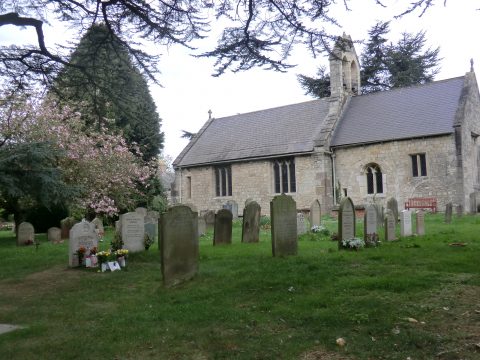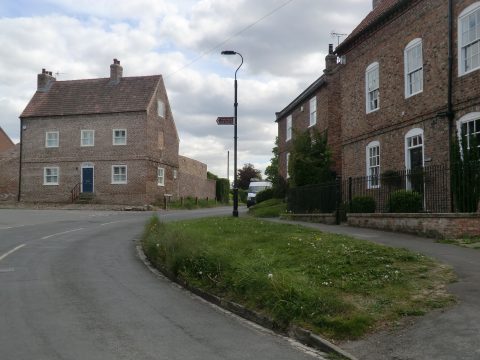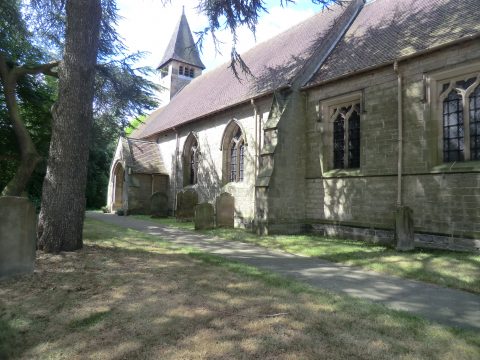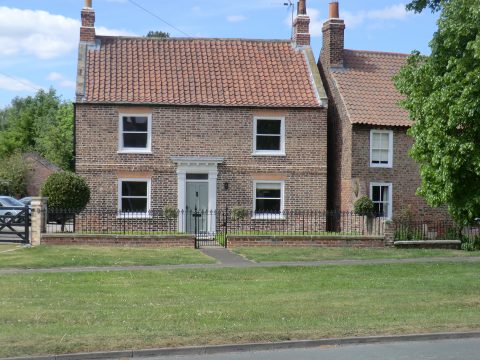NETHER POPPLETON CONSERVATION AREA NO 17 ( 19.7 ha)
INTRODUCTION
Nether Poppleton Conservation Area was designated in 1883. It includes the historic village core around St Everild’s Church, Manor Farm, Church Lane and Main Street.
History
The Old English name “popel” probably means ” pebble” and “tun” implies a non-forested landscape or hamlet/farm. So Poppleton may have originated as a farmstead on pebbly soil. Nether suggests this settlement as the one closer to the river. The earliest reference to Nether Poppleton is in a charter of Archbishop Oswald of 972, St Everlilda’s Church ( only one other dedication to this obscure 7C Saxon Saint if known) is mentioned in the Doomsday Book. In 1088 St Everlida’s and the manor of Nether Poppleton were given by Osbern de Arches to St Mary’s Abbey in York, an association which continued until the Dissolution. The moated site between river and the present 18C Manor House may well be the site of its medieval predecessor. Over 350 years ago, it is reputed that Prince Rupert quartered his troops in the Tithe Bar, before being defeated at Marston Moor. The original Ferryman’s cottage linked Poppleton to the Roman Road to the north. The Village remained virtually unaltered until the 20C expansion as a commuter settlement. The present population is about 1530 people
Important Buildings.
 The Church of St Everilda’s ( listed Grade 11*) is 12C in origin with late medieval and subsequent rebuilding and restoration. It is build in limestone rubble and ashlar, with sandstone and brick in English Garden wall bond, and has a welsh slate roof. The Church includes some 14C window glass. Manor Farm is a group of important listed buildings, the Farmhouse ( mid 18C with a 19C addition), the garage ( probably 18c with walls approximately one metre thick) and the Barn of 15C or 16C origins, encased in brick in the 18C and a rebuilt east end and repairs in 1928. Main Street and its junction with Church Lnae contains several 18C listed house, including the former schoolhouse of 1797. The gazebo north of the Fox Inn ( now part of Fox Garth development) is listed and dates from 1795.
The Church of St Everilda’s ( listed Grade 11*) is 12C in origin with late medieval and subsequent rebuilding and restoration. It is build in limestone rubble and ashlar, with sandstone and brick in English Garden wall bond, and has a welsh slate roof. The Church includes some 14C window glass. Manor Farm is a group of important listed buildings, the Farmhouse ( mid 18C with a 19C addition), the garage ( probably 18c with walls approximately one metre thick) and the Barn of 15C or 16C origins, encased in brick in the 18C and a rebuilt east end and repairs in 1928. Main Street and its junction with Church Lnae contains several 18C listed house, including the former schoolhouse of 1797. The gazebo north of the Fox Inn ( now part of Fox Garth development) is listed and dates from 1795.
The Tithe Barn was restored in 1999 and is a popular venue used by the community for receptions.
Character

In the picture gallery on the Parish Council website are many pictures of the area. A visit is recommended. The popular Millennium Green provides a wonderful outdoor space enjoyed by all the villagers.
The Main Elements of the character of and appearance of the area are:
- The Genuinely rural character of Manor Farm and St Everilda’s Church and the historic association with the origins of the village.
- The Continuity of Church Lane and Main Street, linking areas of historic and rural character through a series of curves and changes in level, revealing a pleasant sequence of views.
- The Landscape element – trees, grass verges – and the way they unify areas of different character. ( it should be noted that earlier cobbled verges exist under some grassed areas).
- The traditional relationship between Nether Poppleton and the river which, with the cluster of historic buildings, keep a sense of identity for the village, bearing in mind the extensive “hinterland” of suburban development has taken place.
UPPER POPPLETON CONSERVATION AREA NO 16 ( 18.2ha)
INTRODUCTION
Upper Poppleton Conservation Area was designated in 1993 originally. It embraced the village green and its approaches along Hodgson Lane and Main Street. On 16 December 2004 The Conservation Area was extended to include the following : Beechway Close, and the adjoing part of Main Street, Part of Long Ridge Lane; land and buildings south of Black Dike Lane; the remainder of Beech Grove and adjoining paddocks and gardens;paddocks to the rear of Model Farm, The Green; and a small extension along School Lane. Also at the same time No 1-5 9consecutive Grove Gardens were deleted from the Conservation Area.
History
The Old English name “popel” probably means ” pebble” and “tun” implies a non-forested landscape or hamlet/farm. So Poppleton may have originated as a farmstead on pebbly soil. Nether suggests this settlement as the one closer to the river. The earliest reference to Nether Poppleton is in a charter of Archbishop Oswald of 972, St Everlilda’s Church ( only one other dedication to this obscure 7C Saxon Saint if known) is mentioned in the Doomsday Book. In 1088 St Everlida’s and the manor of Nether Poppleton were given by Osbern de Arches to St Mary’s Abbey in York, an association which continued until the Dissolution.
Thh original manor house was probably sited close to the present house of that name. All Saints Church ws originally a “minster” church, thought to be of Norman beginnings, but was rebuilt in 1891. Thje railway came to Poppleton in 1884, later facilitating extensive 20C development as a commuter settlement, the present population being about 1900 people
Important Buildings.
 Several of the houses and farmhouses around the village green are listed buildings including Model Farmhouse and Barn, the Manor Farmhouse, together with their gates and railings. The listed buildings all date from the 18C Although not listed, All Saint’s Church is also important to the character of the green.
Several of the houses and farmhouses around the village green are listed buildings including Model Farmhouse and Barn, the Manor Farmhouse, together with their gates and railings. The listed buildings all date from the 18C Although not listed, All Saint’s Church is also important to the character of the green.
Character
The triangular village green overlooked by houses on all sides creates Upper Poppleton’s particular character. Roads approach each corner of the green and along two of these – Main Street and Hodgson Lane – subsidiary green extend. Overall there is an interesting spatial quality , to which the several mature trees contribute. The pump and maypole epitomise the role of the green as the focal point of village life.
 Attractive groups of 18C and 19C two-storey houses front onto the green, interspersed by some more recent developments. The houses tend to be in pairs. The are sited close together often having small front gardens defined by boundary walls with several examples of fine wrought iron railings and gates.
Attractive groups of 18C and 19C two-storey houses front onto the green, interspersed by some more recent developments. The houses tend to be in pairs. The are sited close together often having small front gardens defined by boundary walls with several examples of fine wrought iron railings and gates.
All Saints’ Church is set back from the frontage and has mature pine trees in the churchyard.
The main Elements of the character and appearance of the area are:
- The essentially rural village quality of the green, with its individual triangular shape and the subsidiary greens leading from it.
- The attractive groups of vernacular building, sufficient to create a cohesive overall character, and a valuable focal point in an area that has undergone extensive suburban expansion.
- The rural setting that remains to the south-east and north-west of the village core

